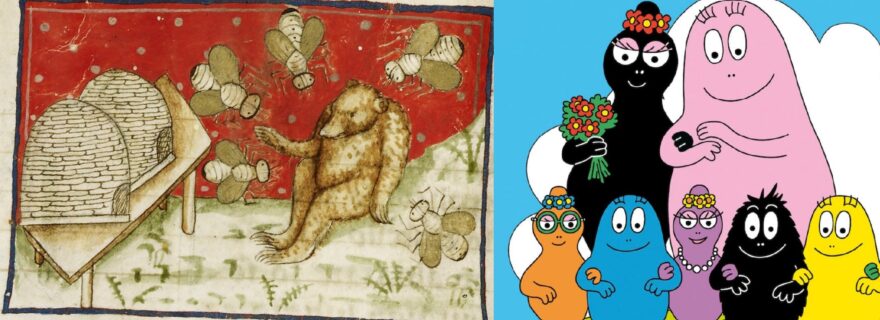Hwæt is on naman? ‘What is in a name?’ Name-giving in Beowulf
What can early medieval naming practices tell us about the Old English epic Beowulf?
Alliterative athelings
In the year 871, on the 23rd of April, Ælfred the Great ascended the throne of the kingdom of Wessex. The start of his reign was preceded by some very tough years for the House of Wessex–beside the large host of Vikings that was wreaking havoc in England. In 858, Alfred’s father Æthelwulf passed away, followed by his Ælfred’s brothers Æthelbald (860), Æthelberht (865) and Æthelred (871). Ælfred’s oldest brother, King Æthelstan of Kent, had died in 852.
One cursory glance at Ælfred’s family tree makes one fact abundantly clear: King Ælfred’s family loved the letter Æ and the word æþel ‘noble’. These days, giving your kids alliterating names seems a bit odd and gimmicky. In the early Middle Ages, however, this Barbapapa-esque practice was a long-standing tradition among Anglo-Saxon royalty, especially among men.
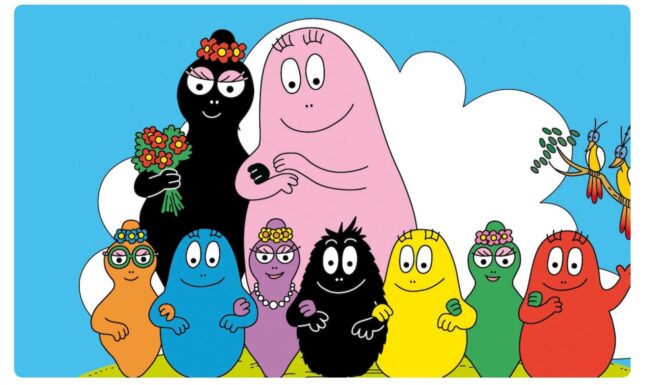

Naming your Anglo-Saxon child in three easy steps
The Anglo-Saxons didn’t start this trend themselves. During the Migration Age, their Continental forefathers already had some firm name-giving principles in place. Germanic names were usually compounds of two so-called ‘themes’; the first theme of a name is called a prototheme and the second theme was called the deuterotheme. Popular themes included words for dangerous animals, like eofor ‘boar’ and wulf ‘wolf’, and warfare, like wig ‘battle’ and ger ‘spear’, as well as more abstract words, like win ‘joy’, þeow (read: theow) ‘servitude’ and ræd ‘counsel’. Think of names such as Old English Cyne-wulf ‘kin-wolf’, Old High German Hilti-brant ‘battle-sword’, Gothic Þiuda-reiks ‘people-king’ and Old Norse Ó-láfr ‘ancestor-descendant’.
The father-son alliteration found in Anglo-Saxon names likewise originates from older Germanic traditions. In fact, one of the earliest Germanic inscriptions, the Gallehus horn inscription (early 5th century), reflects this tradition: ek, Hlewagastiʀ Holtijaʀ horna tawido ‘I, Hlewagast, son of Holt, made this horn’.
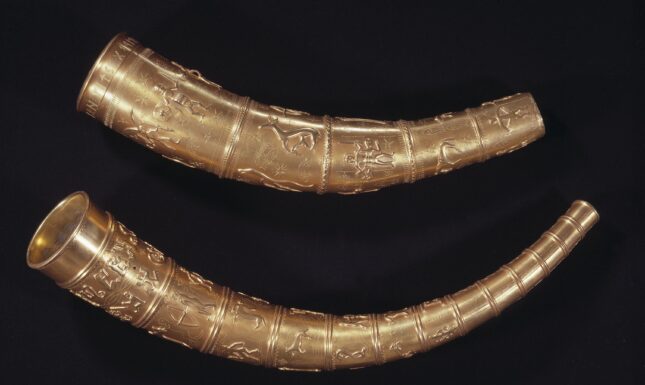
The different ways of creating a good Old English personal name are best explained through an example. Imagine a West-Saxon nobleman called Eadwin. Eadwin’s wife just gave birth to a baby boy. What options would Eadwin have for naming his son?
His first option is alliteration, where his son’s name would start with the same letter as his. He could, for instance, call his son Ealdred or Edgar, though any initial vowel would do the trick; Ælfred’s son was called Eadweard.
His second option is variation, where one of the themes of Eadwin’s name appears in his son’s name. For example, Eadwin could call his son Aldwin by changing the prototheme (front-variation), or Eadberht by changing the deuterotheme (end-variation). In some rare instances, the resulting name was actually a blend of the names of the parents, as was the case for Wulfstan of Worcester, whose parents were called Æthelstan and Wulfgifu.
His third option, repetition, is still popular today; Eadwin could simply choose to name his son Eadwin (Woolf 1939, 1-2).
Thematic thedes
Beowulf is by far the longest and most expansive Anglo-Saxon poem. It details the exploits of a monster-slaying glory-seeking hero called Beowulf, who travels from his native Geatland (possibly Götland in Sweden) to the court of King Hrothgar of the Spear-Danes, where he fights the monster Grendel and Grendel’s mother, after which he becomes king and dies in battle with a dragon. The poem is a rich source of Germanic personal names. It features an ensemble cast of (semi-)legendary Migration Age heroes, whose originally Norse names were faithfully converted to Old English by the poet–with the exception of Scyld Scefing’s son Beowa, who was erroneously identified as ‘Beowulf’ by one of the scribes. The most intricately described family tree in Beowulf is that of the Danes:
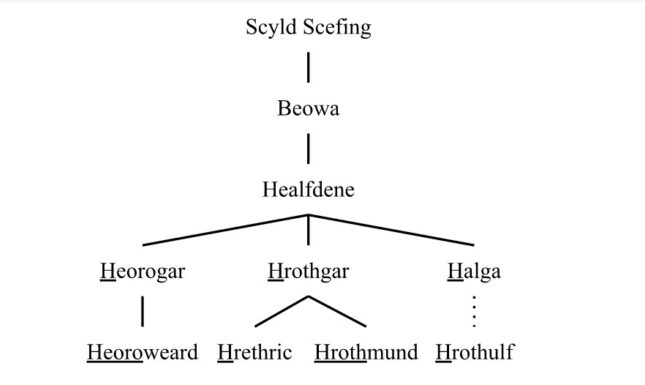
Clearly, from Healfdene onward, the Danes developed a taste for the H. Father-son variation occurs twice, in Heoroweard and Hrothmund. Interestingly, Halga seemingly named his son Hrothulf in honour of his brother Hrothgar. This is rather unfortunate, as the Beowulf-poet alleges–and Scandinavian sources tell us–that Hrothulf would end up betraying his uncle, killing his nephew Hrethric and usurping the Danish throne (allegedly, see Osborn, M, “The Alleged Murder of Hrethric in Beowulf”, 2019). Beside the ‘main’ family tree in fig. 1, the same alliteration also occurs in the Finnesburh episode, in which the Danish royals are called Hoc, Hnæf and Hildeburh. Now for Beowulf’s people, the Geats:
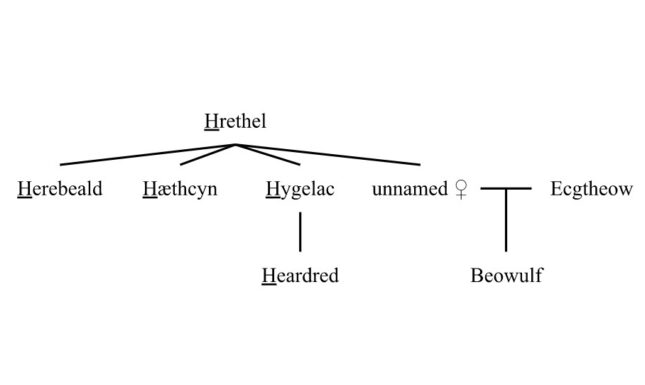
Like the Danes, the Geats have a seeming obsession with the H, even in the female line; Hygelac’s wife Hygd is the daughter of Hæreth and the sister of Hereric. Unlike the Danes, however, no variation is found in the Geatish royal line. Whether the similarities between Danish and Geatish name-giving traditions implies some deeper kinship or alliance between the two families is unclear (Woolf 1939, 146-52).
Wherefore art thou Beowulf?
Figure 2 makes one thing glaringly obvious: Beowulf’s name doesn’t quite fit, as it does not start with an H. This fact was enough for Chambers to declare that the Beowulf-poet invented the name and “violently inserted [it] amid the historic names of the kings of the Geatas” (Chambers 1932: 10). Here, Chambers did not take the learnedness of the Beowulf-poet into account. The poet was clearly incredibly knowledgeable about Migration Age royalty, so the idea that he would not have picked up on this clear alliterative tradition seems far fetched. Besides, Beowulf was related to the Geatish royal house through his mother, meaning he was likely exempt from the H-initial naming conventions.
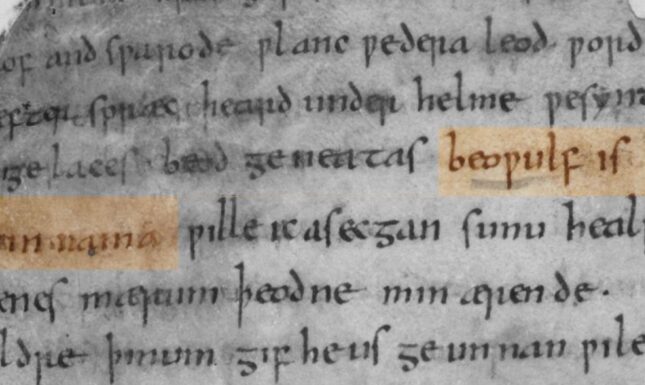
More inexplicably, Beowulf’s name does not alliterate or vary with his father’s name, Ecgtheow, as the expected name of Ecgtheow’s son would start with a vowel. This poses a problem, as all sons in Beowulf bear names that alliterate with their fathers’. In 1939, Woolf suggested that Beowulf may have been a nom de guerre and attempted to find Beowulf’s ‘real name’ in the poem. His most promising contender was Ælfhere, a name belonging to one of the Geats, though only on the basis that Ælfhere is a Geat and his name alliterates with Ecgtheow (Woolf 1939, 157).
Present-day Beowulf scholarship is not as preoccupied with the historicity of the poem, so the fact that Beowulf’s name does not fit in the Geatish family tree is taken for granted and the quest for an alliterating alternative name has long been abandoned. That’s not to say that Beowulf’s name has gone without study since then. The origin of the name Beowulf has been, and remains, a popular topic among scholars.
Bee-wolf, Beer-wolf, Bath-wolf
Jacob Grimm (yes, one of the Brothers Grimm of fairytale fame) interpreted the name as beo ‘bee’ + wulf ‘wolf’, which has remained the most popular. The name is a kenning, a kind of compound that alludes to the nature of the thing it describes, while remaining a little mysterious, like the hronrad ‘whale-road’, which means ‘the sea’. ‘Bee-wolf’ (diplomatically translated as ‘bee-foe’) is generally accepted to have meant ‘bear’, named for the animal’s characteristic love of honey. This interpretation ties the character Beowulf to a widespread tradition of bear-like men travelling to foreign courts to fight evil monsters. However, Neidorf and Zhu’s 2021 survey of Germanic personal names concluded that bees were seen as distinctly feminine in Germanic cultures, which would not be in line with the (toxically) masculine Beowulf. Besides, insects were rarely (possibly never) used as themes in Germanic personal names (Neidorf and Zhu 2022, 117-9).
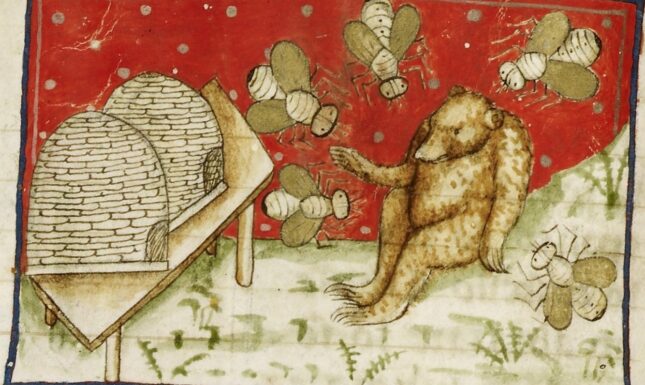
A more novel theory is that the name Beowulf may have originated from beow ‘barley’ + wulf ‘wolf’. Beer, which was made from barley, was a popular beverage in early mediaeval Europe. A beer aficionado could have earned the nickname Beer-wolf. Alternatively, he may have been named after the Germanic god Beow (Old Norse Byggvir), making Beowulf the ‘wolf of Beow’, though Beowulf’s link to an obscure agricultural god is unclear (Sayers 2022, 1-3).
Probably the most recent theory was proposed by Sayers, who theorised that Beowulf may have been called *Baþ-olfr ‘battle-wolf’ in Gutnish (the asterisk (*) indicates that this word is not attested, i.e. found in the written record, but linguistically reconstructed), but the poet misinterpreted the name as Bæþ-ulf ‘bath-wolf’ or Bǣd-ulf ‘effeminate wolf’, leading him to change it to Beowulf (possibly to connect him to Beowa, the son of Scyld Scefing) so his protagonist would not be associated with cleanliness or–God forbid–femininity (Sayers 2022, 1-3).
Other onomastic oddities
Beowulf is not the only character in the poem with an odd name. During the Geats’ first night in Heorot, Grendel enters the hall and wreaks havoc, indiscriminately killing Beowulf’s kinsmen. The first victim of Grendel’s wrath is a man who, curiously, is called Hondscio ‘hand-shoe’. Needless to say, this name was not common in Germanic heroic legend and only appears in Beowulf. Like Dutch handschoen and German Handschuh, the word Hondscio can only have meant ‘glove’. In the poem, Hondscio is mentioned only a few lines before the poet addresses Grendel’s glōf ‘glove’, which might mean that the Beowulf-poet simply misinterpreted some earlier version of the story and took hondscio to be the name of Grendel’s victim, rather than Grendel’s glove (Neidorf 2022, 160).
Then there is Unferth. Like Hondscio, the name Unferth only appears in Beowulf, and for good reason. Traditionally, the name is interpreted as ‘un-peace’ or ‘un-friend’, not exactly a name you’d want a child to grow up with. In Unferth’s case, nomen est omen; Unferth’s role in the story is to challenge Beowulf to a flyting match, a ritualised verbal argument similar to a rap battle. Envious of Beowulf’s fame, Unferth accuses him of being a fool and losing a swimming match. Beowulf retorts that he only lost because he was too busy fighting sea monsters, adding that he’d heard rumours that Unferth was a kinslayer, after which Unferth backs off. There are, however, a number of competing theories on Unferth’s origin, on which see Fulk 1987.
Like Unferth, it seems that Wiglaf was also named for his function in the story; during Beowulf’s final stand against the dragon, Wiglaf is Beowulf’s only retainer who sticks around until the bitter end while the others flee the bloodshed. Fittingly, the name of Beowulf’s bravest kinsman is comprised of wig ‘battle’ (like in the name Ludwig) and laf ‘remainder’, essentially meaning ‘battle-survivor’ or ‘one who is left in battle’.
In short, like many Anglo-Saxon æthelings did for their children, the Beowulf poet did not pick the names for his characters at random and put considerable thought into his onomastic choices. What's in a name? Quite a bit!
Bibliography
- Fulk, R. D. “Unferth and His Name.” Modern Philology 85, no. 2 (1987): 113–27. https://www.jstor.org/stable/437181.
- Neidorf, Leonard. “Names and Naming in Beowulf: Studies in Heroic Narrative Tradition: By Philip A. Shaw, London, Bloomsbury Academic, 2020, 232 Pp., $115 (Hardback), ISBN: 9781350145764.” English Studies 103, no. 1 (2022): 158–62. https://doi.org/10.1080/0013838X.2021.1966928.
- Neidorf, Leonard, and Chenyun Zhu. “The Germanic Onomasticon and the Etymology of Beowulf’s Name.” Neophilologus 106, no. 1 (2022): 109–26. https://doi.org/10.1007/s11061-021-09703-8.
- Sayers, William. “The Origin of the Name Beowulf in a Gutnish *baþolfr ‘Battle-Wolf.’” ANQ: A Quarterly Journal of Short Articles, Notes and Reviews (March 22, 2022): 1–4. https://doi.org/10.1080/0895769X.2022.2056428.
- Woolf, Henry Bosley. The Old Germanic Principles of Name-Giving. Baltimore, 1939.
© Simon den Hertog and Leiden Medievalists Blog, 2023. Unauthorised use and/or duplication of this material without express and written permission from this site’s author and/or owner is strictly prohibited. Excerpts and links may be used, provided that full and clear credit is given to Simon den Hertog and Leiden Medievalists Blog with appropriate and specific direction to the original content.


